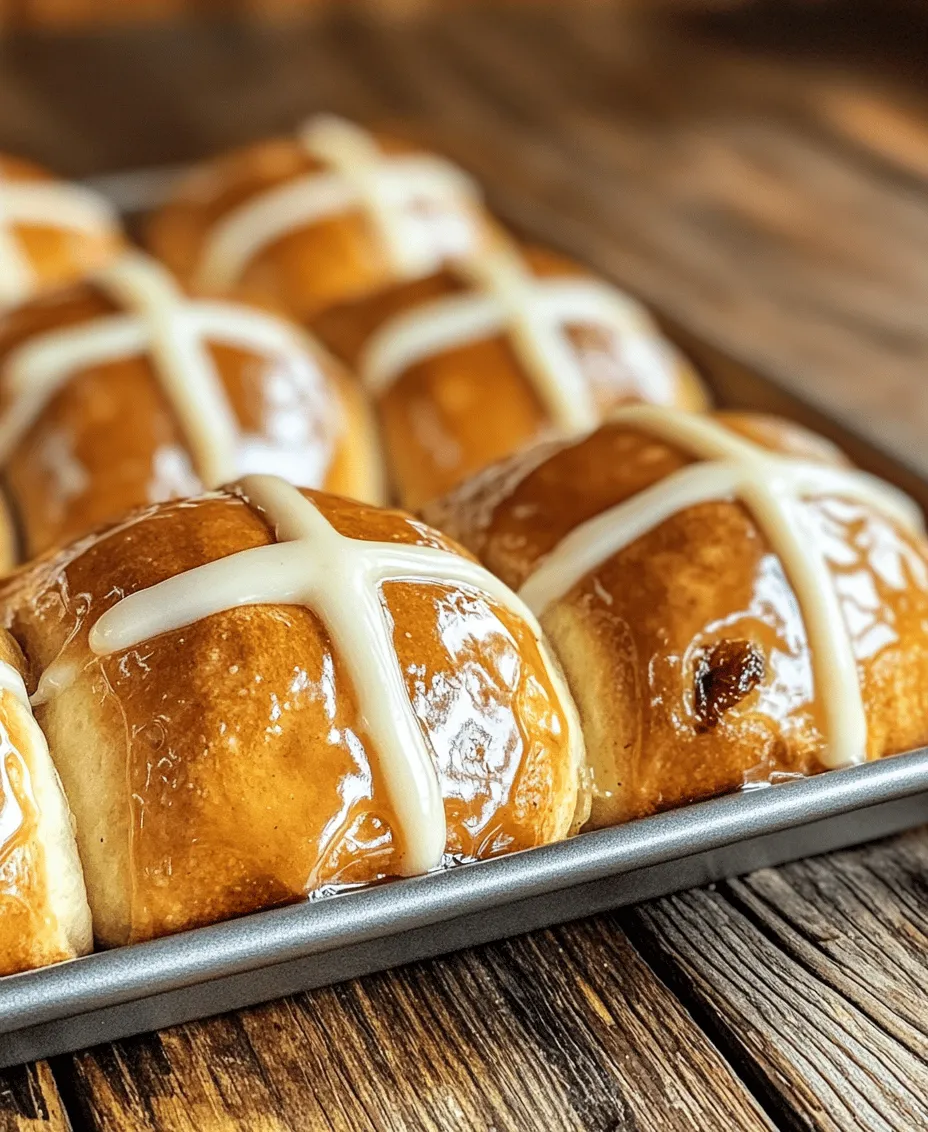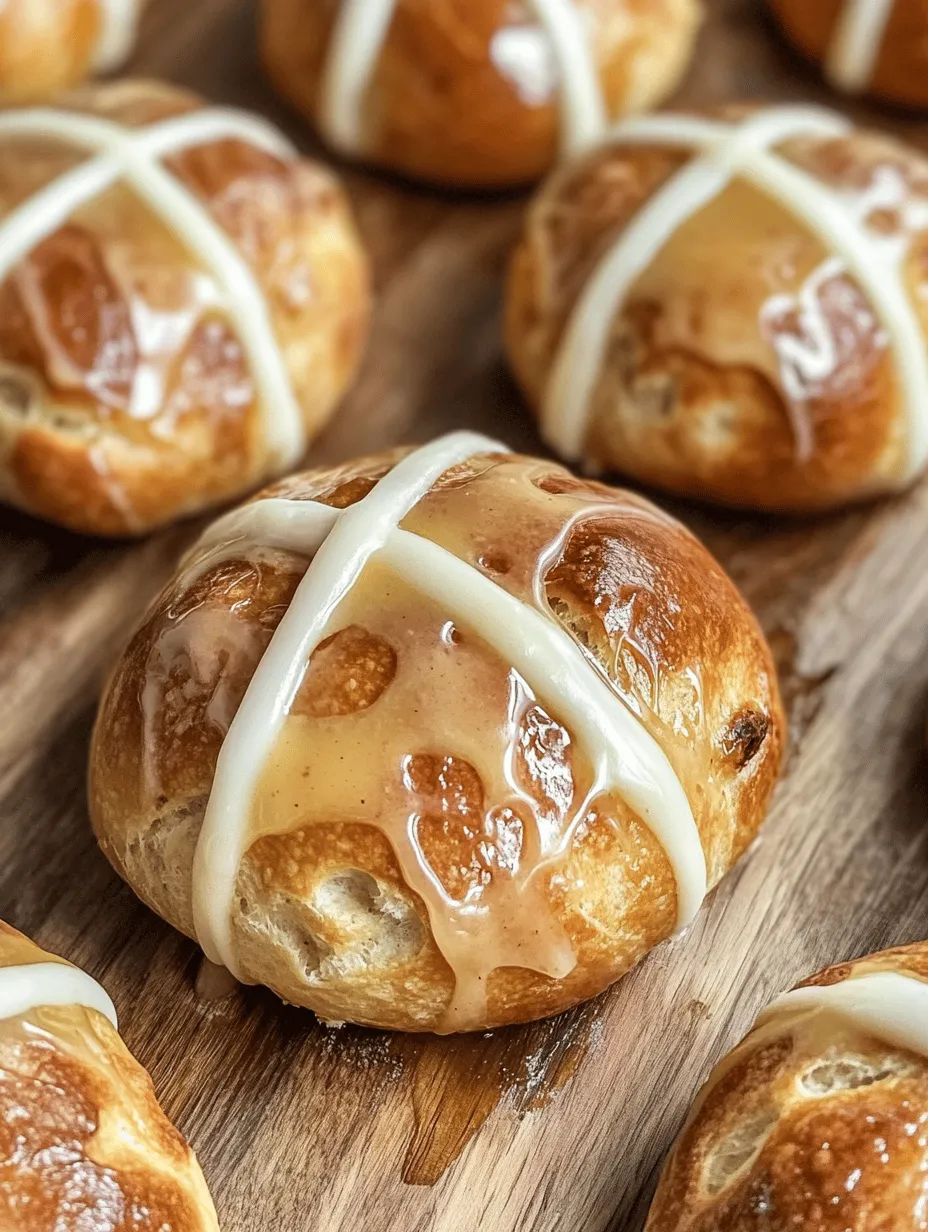Introduction
Hot Cross Buns, with their fragrant aroma of spices and the sweet hint of dried fruits, have become a staple in Easter celebrations for centuries. These soft, pillowy buns, adorned with a signature cross, symbolize the end of Lent and the joy of resurrection. While their historical roots trace back to England, the tradition of baking Hot Cross Buns has transcended cultural boundaries, making them a beloved treat in many households around the world.
The allure of creating Hot Cross Buns at home lies not just in the delightful flavor but also in the comforting process of baking. The warmth of the oven fills the kitchen, inviting family and friends to gather around. As the buns rise and bake, they release an irresistible scent that evokes nostalgia and creates a sense of togetherness. This recipe promises to guide you through the art of making these delightful treats, ensuring that you can share the joy of homemade Hot Cross Buns with your loved ones, whether during Easter or any other festive occasion.
The History of Hot Cross Buns
The origins of Hot Cross Buns can be traced back to ancient times, with various cultures contributing to their evolution. One of the earliest mentions of spiced buns dates back to the 12th century when a monk in St. Albans, England, was said to have baked the first buns in honor of Good Friday. This tradition soon spread, with the buns becoming associated with Easter celebrations as symbols of Christ’s crucifixion.
The distinctive cross on the buns holds significant meaning, representing the crucifixion and serving as a reminder of the sacrifice made. Historically, the cross was made from a simple paste of flour and water, but over time, it has evolved into a more decorative icing, enhancing both the visual appeal and the flavor of the buns.
As time progressed, Hot Cross Buns began to evolve further, with bakers experimenting with different ingredients, flavors, and shapes. The introduction of spices like cinnamon and nutmeg, along with the inclusion of dried fruits and candied peel, transformed the simple bun into a rich and aromatic treat. In modern times, variations abound—some bakers incorporate chocolate, nuts, or even savory elements, catering to diverse palates while still honoring the traditional recipe.
Despite these adaptations, the core essence of Hot Cross Buns remains unchanged. They symbolize hope, renewal, and the joy of sharing baked goods with loved ones, making them a timeless favorite.
Understanding the Ingredients
To create the perfect Hot Cross Buns, it’s essential to understand the role each ingredient plays in the recipe. This not only enhances your baking skills but also allows you to appreciate the delicate balance of flavors and textures that make these buns so delightful.
All-Purpose Flour
All-purpose flour is the foundation of any bread recipe, including Hot Cross Buns. It provides the necessary structure and gluten development needed for the dough to rise and hold its shape. The protein content in all-purpose flour typically ranges from 10-12%, making it versatile for various types of baked goods. When mixed with water and kneaded, the proteins form gluten, which gives the buns their characteristic texture—light, airy, and slightly chewy.
Sugar
Sugar is not just a sweetener; it plays a crucial role in the fermentation process. When combined with yeast, sugar serves as food, allowing the yeast to produce carbon dioxide gas, which causes the dough to rise. Additionally, sugar enhances the flavor of the buns and contributes to their golden-brown crust when baked. For Hot Cross Buns, granulated sugar is commonly used, but brown sugar can also add a hint of caramel flavor.
Active Dry Yeast
Active dry yeast is the leavening agent responsible for the buns’ fluffy texture. This type of yeast is dormant until activated by warmth and moisture. When combined with warm liquid and sugar, the yeast begins to feed and produce carbon dioxide, which causes the dough to rise. It’s vital to ensure that the water used to activate the yeast is not too hot, as extreme temperatures can kill the yeast, leading to a dense batch of buns.
Spices: Cinnamon and Nutmeg
Cinnamon and nutmeg are the star spices in Hot Cross Buns, providing warmth and depth to the flavor profile. Cinnamon, with its sweet and slightly spicy notes, pairs beautifully with the dried fruits in the buns, while nutmeg adds a subtle earthiness. Beyond their flavor, both spices come with health benefits. Cinnamon is known for its anti-inflammatory properties and can help regulate blood sugar levels, while nutmeg is rich in antioxidants and has been used traditionally for its digestive benefits.
Dried Fruits and Candied Orange Peel
The choice of dried fruits is key to the overall flavor and texture of Hot Cross Buns. Traditionally, currants and raisins are used for their sweetness and chewy texture, but you can experiment with other dried fruits such as cranberries or apricots. Candied orange peel adds a bright citrus flavor that complements the spices and enhances the aromatic profile of the buns. The combination of these fruits creates a delightful contrast to the soft dough, making each bite a flavorful experience.
Butter and Eggs
Butter and eggs are essential for enriching the dough, contributing to its tenderness and moisture. Butter adds a rich flavor and helps create a soft crumb, while eggs provide structure and stability, binding the ingredients together. The fats in butter also aid in browning, giving the buns their appealing golden crust. Together, these ingredients elevate the overall quality of Hot Cross Buns, making them indulgent and satisfying.
Glaze Ingredients: Apricot Jam and Water
The glaze is the finishing touch that enhances both the flavor and appearance of Hot Cross Buns. A simple mixture of apricot jam and water creates a glossy sheen that adds a touch of sweetness. This glaze not only makes the buns visually enticing but also seals in moisture, keeping them fresh for longer. Applying the glaze right after baking ensures that the buns shine and look appetizing, making them even more inviting to share.
Step-by-Step Instructions for Making Hot Cross Buns
Once you have gathered all your ingredients and understood their roles, it’s time to embark on the delightful journey of making Hot Cross Buns. The process can be broken down into several key steps, each requiring attention to detail to ensure the best results.
Preparing the Dough
1. Mixing Dry Ingredients: Begin by measuring out the all-purpose flour, sugar, salt, and spices in a large mixing bowl. Whisk them together to ensure even distribution. The salt is crucial, as it helps control yeast activity and enhances the flavor, but be careful not to place it directly on top of the yeast when you add it later, as it can hinder the yeast’s effectiveness.
2. Activating the Yeast: In a separate bowl, combine warm water (ideally around 110°F or 43°C) with the active dry yeast and a teaspoon of sugar. Allow the mixture to sit for about 5-10 minutes until it becomes frothy. This indicates that the yeast is active and ready to leaven the dough.
3. Combining Wet Ingredients: In another mixing bowl, whisk together the eggs and melted butter. Once the yeast mixture is frothy, combine it with the egg mixture. Gradually add this liquid mixture to the dry ingredients, stirring until a shaggy dough forms.
4. Kneading the Dough: Transfer the dough onto a lightly floured surface and knead it for about 8-10 minutes. Kneading develops the gluten, which is essential for achieving the right texture in your buns. The dough should become smooth and elastic; if it’s too sticky, sprinkle a little more flour as needed.
5. Incorporating Dried Fruits and Candied Peel: Once the dough is kneaded, gently fold in the dried fruits and candied orange peel. Ensure they are evenly distributed throughout the dough. This step adds texture and bursts of flavor to your Hot Cross Buns.
Proving the Dough
After preparing the dough, it’s time to let it rise. Place the dough in a greased bowl, cover it with a damp cloth or plastic wrap, and let it rise in a warm, draft-free area for about 1-2 hours, or until it has doubled in size. This fermentation process allows the yeast to work its magic, creating air pockets that will give your buns their light and fluffy texture.
These initial steps set the foundation for your Hot Cross Buns Delight. As the dough rises, the anticipation of enjoying these aromatic treats grows, making the process even more rewarding. In the next part of this article, we will delve into the remaining steps, including shaping the buns and baking them to perfection, along with tips for achieving the best results. Stay tuned to unlock the full potential of this traditional Easter recipe!

Mixing and Kneading
Once your ingredients are prepped, it’s time to combine them into a beautiful dough. In a large mixing bowl, combine the flour, sugar, salt, and spices, creating a well in the center for the yeast mixture. Pour in the warmed milk and melted butter, followed by the beaten egg. Using a wooden spoon or your hands, mix the ingredients until a shaggy dough begins to form.
Kneading is a crucial step to develop the gluten, which gives the buns their delightful texture. Turn the dough out onto a lightly floured surface and knead it for about 8-10 minutes. Aim for a smooth and elastic consistency; the dough should spring back when poked. If the dough feels too sticky, add a little more flour as needed, but be cautious not to overdo it. The ideal dough should be slightly tacky but not overly wet.
Incorporating Dried Fruits
Dried fruits are essential for that classic Hot Cross Bun flavor. After kneading, flatten the dough gently into a rectangle. Evenly distribute your chosen dried fruits—commonly currants, raisins, or sultanas—across the surface. Use the heel of your hand to gently press the fruits into the dough while folding it over itself. This technique ensures the fruits are well incorporated without tearing the dough. Once the fruits are mixed in, knead the dough for another minute or two to ensure even distribution.
Rising Process
The rising process is critical for achieving soft, fluffy buns. First, place the formed dough into a lightly greased bowl, covering it with a damp cloth or plastic wrap to retain moisture. Set the bowl in a warm, draft-free area—an oven preheated to 200°F (93°C) and then turned off is ideal. Allow the dough to rise until it has doubled in size, which typically takes about 1 to 1.5 hours.
After the first rise, gently punch down the dough to release excess air. Shape it into a ball, and let it rest for 10 minutes before proceeding to the second rise. For this, divide the dough into equal portions (about 12 pieces for average-sized buns). Shape each piece into a ball and place them on a lined baking tray, ensuring they are close but not touching. Cover them again and let them rise for another 30-45 minutes until puffed.
Shaping the Buns
Shaping the buns correctly not only ensures they cook evenly but also gives them that signature round appearance. To shape, flatten each dough piece slightly before folding the edges toward the center. Pinch them together to seal and turn the bun over so the seam is on the bottom. Roll it gently on the countertop to create a smooth top. As you arrange the buns on the baking tray, ensure they have enough space to expand without merging into one another during baking.
Creating the Crosses
The traditional cross on Hot Cross Buns is both decorative and symbolic. To create the cross, combine flour and water in a small bowl to form a thick paste. You want the mixture to be pipeable but not too runny. Transfer it to a piping bag or a plastic bag with the corner snipped off. Pipe a cross over each bun, ensuring it is even and defined. This step adds a delightful visual appeal and makes each bun instantly recognizable.
Baking and Glazing
Preheat your oven to 375°F (190°C) while the buns are rising for the final time. Once the buns have puffed up nicely, place the tray in the oven and bake for 20-25 minutes until they are golden brown. To ensure they are cooked through, tap the bottom of a bun; it should sound hollow.
For a glossy finish, prepare a simple glaze by heating equal parts water and sugar until dissolved. Brush this mixture over the warm buns immediately after taking them out of the oven, allowing it to soak in for a beautiful sheen.
Tips for Perfecting Your Hot Cross Buns
Common Mistakes to Avoid
Creating perfect Hot Cross Buns can be tricky. Be mindful of these common mistakes:
– Over-kneading: While kneading is essential, overdoing it can lead to tough buns. Knead just until the dough is elastic.
– Under-rising: If your dough hasn’t risen sufficiently, the buns will be dense. Ensure they are in a warm area, and give them ample time to rise.
– Improper baking temperatures: An oven that’s too hot can cause the buns to brown too quickly, while too low may result in doughy centers. Always use an oven thermometer if you’re unsure.
Variations and Customizations
Hot Cross Buns are versatile, and you can customize them to suit your taste:
– Spices: While cinnamon and nutmeg are traditional, consider adding cardamom or ginger for an aromatic twist.
– Dried fruits: Experiment with cranberries, apricots, or even chocolate chips for a modern take.
– Zest: Adding citrus zest, such as orange or lemon, can brighten the flavors and enhance the aroma.
Storing and Reheating Buns
To keep your Hot Cross Buns fresh, store them in an airtight container at room temperature for up to 3 days. If you want to keep them longer, consider freezing them. Wrap each bun individually in plastic wrap and then place them in a freezer bag. They can be frozen for up to 3 months. When you’re ready to enjoy them, thaw at room temperature, then reheat in the oven at 350°F (175°C) for a few minutes until warm.
Pairing Suggestions for Hot Cross Buns
Hot Cross Buns are delightful on their own, but pairing them with the right beverages or spreads can elevate the experience. Here are some suggestions:
– Beverage Pairings: A warm cup of tea, a rich coffee, or a glass of milk complements the sweet and spicy flavors of the buns beautifully.
– Serving Suggestions: Spread a little butter on warm buns for a classic treat, or try cream cheese and a drizzle of honey for a richer option. Jams, especially fruit preserves like apricot or raspberry, add a delightful contrast.
– Incorporating into Meals: Hot Cross Buns can be a lovely addition to brunch gatherings or holiday meals. Serve them alongside a cheese platter or as part of a festive spread.
Nutritional Information
Each Hot Cross Bun contains approximately 180-200 calories, depending on the specific ingredients used. Here’s a general breakdown of the nutritional content per bun:
– Calories: 190
– Total Fat: 5g
– Saturated Fat: 2g
– Carbohydrates: 33g
– Dietary Fiber: 1g
– Sugars: 9g
– Protein: 4g
Hot Cross Buns are vegetarian-friendly and can be made nut-free by avoiding nut-based ingredients. For those with dietary restrictions, consider substituting dairy with plant-based alternatives like almond or soy milk.
Conclusion
Making Hot Cross Buns at home is not just about the end product; it’s about the joy of baking and the tradition of sharing these delicious treats with family and friends. Whether you enjoy them fresh out of the oven or toasted with a spread, these buns hold a special place in many hearts, especially during the Easter season.
Encourage your loved ones to join you in the kitchen, fostering a sense of community through cooking. The process of kneading, shaping, and baking creates lasting memories and delicious rewards. With their rich history and delightful flavors, Hot Cross Buns are a recipe that can be cherished year after year, transcending seasons and celebrations.



